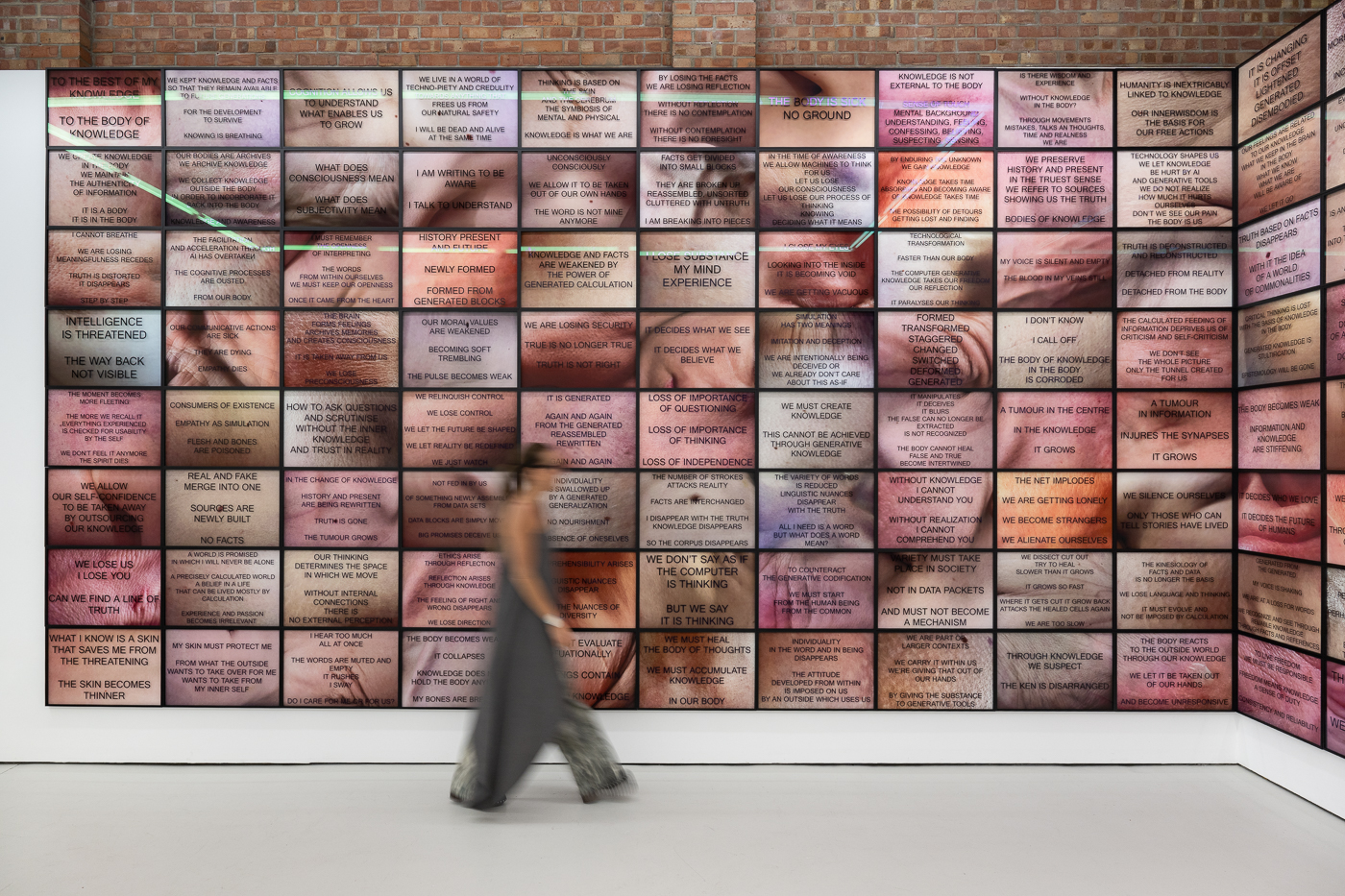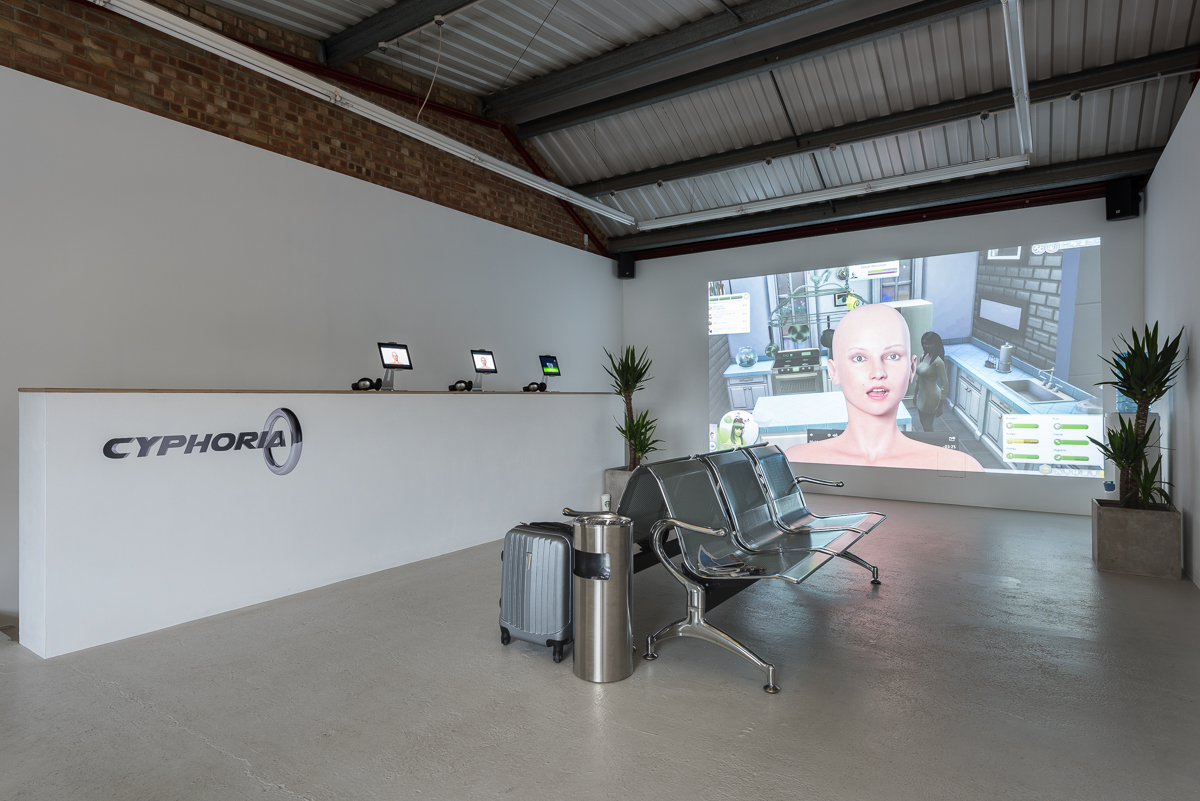Stine Deja spoke to Charlotte Barnard at Traction Magazine about the capitalisation of human emotion in light of her recent show Cyphoria at Annka Kultys Gallery.
147. Stine Deja
By Charlotte Barnard
Denmark-born and London-based artist, Stine Deja talks with Charlotte Barnard for Traction about her recent solo exhibition ‘Cyphoria’ at Annka Kultys, marking her first with the gallery.
Deja utilises an artful manipulation of video and digital media to create synthetic realities composed of highly polished and skilfully rendered architectural spaces and human avatars. These act as an interrogative tool, examining the ways in which the techno-sphere and digital technologies have altered human connectivity and understanding of self.
Through navigating the interstices between virtual and real worlds, in ‘Cyphoria’, the capitalisation of human emotion by the techno-bubble has been laid bare. In the staging of an immersive installation, physically resemblant of an airport departure lounge, Deja invited the audience to acknowledge their complicity in this contemporary extension and subversion of human existence. Encouraged to actively participate in becoming a ‘cyber traveller’; from the ‘irl’ physical acts of taking a seat, a drink of water, adding to the rubbish in the bin; to the virtual experience elicited through the visuals and voice-over, the viewer is forced to confront and be cognisant of the ways in which we transfer value and recognise ourselves through the screen of digital media.
‘Cyphoria’ at Annka Kulty’s, is the first time I have come across your work. You use digitally rendered video to pose questions around the growing dependence of human connection on digital media. What interests you so much about this area of contemporary life?
In an age of digital dependency and mass migration to ‘virtual’ spaces, I find it super interesting to explore the overlaps and gaps, the malleable borders of the ‘real’ and the ‘virtual’. Digital technologies are now almost ubiquitous in every part of our lives and as they become more advanced and integrated they become more invisible.
In the Western context at least, we are continually occupying hybrid spaces, where people are simultaneously off and online, using objects that are technologically attached and detached. This has affected intimacy as people try to come together whilst maintaining their connection to everything else. I love observing and participating in this (contemporary) life.
We are welcomed into a physical space resemblant of an airport departure lounge. The imagery in the video also references this and we are informed by the voice-over that we are going on a ‘journey’. Could you discuss what interests you about this space as a platform for what is discussed in the work?
I chose the airport because I see it as a transient space with boundaries (and borders) that react to the person crossing them. I wanted to try and overlap this metaphor with the ways in which humans now ‘travel’ on and offline as part of their daily routine. The internet, when constantly accessible, offers infinite ‘destinations’ and each of those routes is unique as it is defined by the imagination of the person navigating it. I thought that the airport aesthetic was appropriate for this reason and it interests me because of it’s muted minimalism and futurist metallic accents that also are woven through the video. I thought that simulating the airport in the space as part of the installation would both mirror the environments in the video whilst also putting the audience in the apprehensive and adventurous frame of mind that airports sometimes put you in.
I was struck by your complex overlapping and intertwining of motifs found in the comprising elements of the show; the video, voice-over, print and installation. It creates an extremely immersive and visceral experience for the viewer, where we are pushed to be ‘active’ participants. Was this the desired effect and, if so, why was it so important to you that the viewer be so implicated in the work?
I definitely wanted to create a space that allowed the participant to give themselves away to the thought experiment. We are so used to watching videos and pictures on our screens all the time, most of which we don’t really digest or take in. We are experts in filtering relevant pixels, therefore I hoped that creating an airport lounge would optimise the relevance of the video and give the viewers a more full sensory experience. Upon arrival at the exhibition participants are actually preparing for a departure and are forced to do the familiar rituals of checking for a flight, waiting, absorbing the environment and other strangers in the space, take a drink, throw things away – perform your private waiting room rituals in the public space.
The print in the show was created by 3D printing your personal items, which was then (if I’m correct?) photographed and digitally manipulated to form the final image. I found the lengthy process you undertook, taking ‘irl’ objects and transforming them into the digitised and flattened, yet still 3-D, end image fascinating. Could you discuss your motives for choosing this process?
The print was created by 3D scanning body parts and personal belongings, such as my toothbrush, underwear and also myself. After digitising those, I put everything into a composition in a 3D software and then it went to print.
The idea behind the print was to prepare myself to be uploaded into cyperspace, I wanted to see what the representation would look like. In the print the objects have shifted, they are suspended and hyper-real. I can easily call upon them when transitioning from the real world to the virtual world. By translating my everyday fixed existence into digital objects I have achieved a deeper nomadic quality, with which I can move. The print is also related to the exhibition as it could be taken as a metaphor of how one’s luggage could look three dimensional but completely flat, like a screen.
Throughout the video piece, and within the installation, you engage water as a motif, here I refer to the Davidoff ‘Cool Water’ advert, the water-based animated text that is used within the video, the reference to ‘floating’ in the voice-over, as well as the water cooler that the viewer is invited to use. I’m interested as to why this element is of such prominence in the work? What interests you about the relationship between this natural element and the digital sphere?
To be honest, before you listed it out, I wasn’t really aware how prominent the water motif was, it happened somewhat unconsciously. I am certainly interested in reflections and playing with ideas of screens as mirrors or portals into environments beyond them. There is a clear narcissism in the ways in which we interact with glossy devices. Whilst a mirror displays back exactly what sits in front of it, a screen on the other hand can alter a persons identity both on and off line, perhaps more like a mirror illusion. In other works I have explored these ideas further and I think that water has become an extension of that.
Davidoff ‘Cool Water’ is a product that to me is inextricably linked to airports in the sense that it is always available in flight and in Duty Free shops. It was intended as a kind of timeless symbol of airport advertising, I just feel like it is something that you could find in any airport in the West for the last decade and the next decade to come.
Carrying on from this question; through aligning the reference to bodies of water with your over-arching engagement in, as said in the press release, “…investigating the extent by which genuine emotional feeling within this virtual domain shapes us as social beings”, I was drawn to inferring elements of hydro-feminist thought onto the work. This was reinforced by your choice to use a female avatar, ‘Alena’, as our guide. Is this an area of research that you are interested in?
I only recently discovered the work of Astrida Neimanis, so need to read more about hydro-feminism before I can answer that really. It certainly wasn’t a direct inspiration because I didn’t know about it at the time! But I am interested in gender and feminism so the choice of Alena wasn’t entirely unconscious.
There is much humour in the work, found as moments of parody and irony. Why do you use humour and what do you feel its value is as a tool?
Sometimes I feel like things become more apparent by highlighting a detail or a contrast, especially if it’s something I find intriguing/weird/funny. Unlike computers we remember something best if we learn it in a context that we understand, or if it’s emotionally important to us. For me humour is a way of emotionally engaging the viewer and its also a way of balancing a lot of information.That being said, I actually don’t think too much about how I use humour in my work whilst making it, I guess it’s more a natural flow of thoughts that luckily sometimes happens to be funny.


